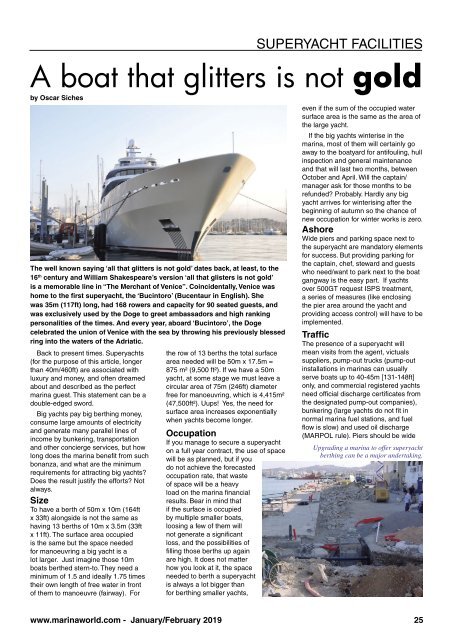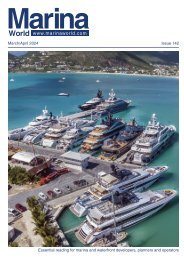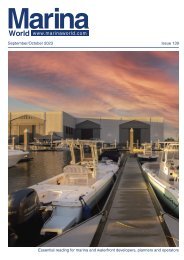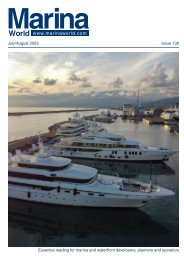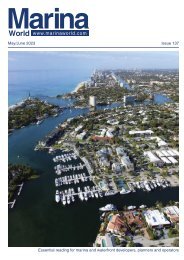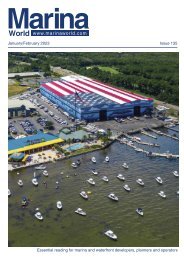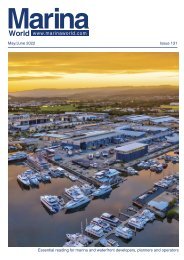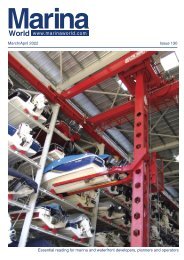January February 2019 Marina World
The magazine for the marina industry
The magazine for the marina industry
You also want an ePaper? Increase the reach of your titles
YUMPU automatically turns print PDFs into web optimized ePapers that Google loves.
SUPERYACHT FACILITIES<br />
A boat that glitters is not gold<br />
by Oscar Siches<br />
The well known saying ‘all that glitters is not gold’ dates back, at least, to the<br />
16 th century and William Shakespeare’s version ‘all that glisters is not gold’<br />
is a memorable line in “The Merchant of Venice”. Coincidentally, Venice was<br />
home to the first superyacht, the ‘Bucintoro’ (Bucentaur in English). She<br />
was 35m (117ft) long, had 168 rowers and capacity for 90 seated guests, and<br />
was exclusively used by the Doge to greet ambassadors and high ranking<br />
personalities of the times. And every year, aboard ‘Bucintoro’, the Doge<br />
celebrated the union of Venice with the sea by throwing his previously blessed<br />
ring into the waters of the Adriatic.<br />
Back to present times. Superyachts<br />
(for the purpose of this article, longer<br />
than 40m/460ft) are associated with<br />
luxury and money, and often dreamed<br />
about and described as the perfect<br />
marina guest. This statement can be a<br />
double-edged sword.<br />
Big yachts pay big berthing money,<br />
consume large amounts of electricity<br />
and generate many parallel lines of<br />
income by bunkering, transportation<br />
and other concierge services, but how<br />
long does the marina benefit from such<br />
bonanza, and what are the minimum<br />
requirements for attracting big yachts?<br />
Does the result justify the efforts? Not<br />
always.<br />
Size<br />
To have a berth of 50m x 10m (164ft<br />
x 33ft) alongside is not the same as<br />
having 13 berths of 10m x 3.5m (33ft<br />
x 11ft). The surface area occupied<br />
is the same but the space needed<br />
for manoeuvring a big yacht is a<br />
lot larger. Just imagine those 10m<br />
boats berthed stern-to. They need a<br />
minimum of 1.5 and ideally 1.75 times<br />
their own length of free water in front<br />
of them to manoeuvre (fairway). For<br />
the row of 13 berths the total surface<br />
area needed will be 50m x 17.5m =<br />
875 m² (9,500 ft²). If we have a 50m<br />
yacht, at some stage we must leave a<br />
circular area of 75m (246ft) diameter<br />
free for manoeuvring, which is 4,415m²<br />
(47,500ft²). Uups! Yes, the need for<br />
surface area increases exponentially<br />
when yachts become longer.<br />
Occupation<br />
If you manage to secure a superyacht<br />
on a full year contract, the use of space<br />
will be as planned, but if you<br />
do not achieve the forecasted<br />
occupation rate, that waste<br />
of space will be a heavy<br />
load on the marina financial<br />
results. Bear in mind that<br />
if the surface is occupied<br />
by multiple smaller boats,<br />
loosing a few of them will<br />
not generate a significant<br />
loss, and the possibilities of<br />
filling those berths up again<br />
are high. It does not matter<br />
how you look at it, the space<br />
needed to berth a superyacht<br />
is always a lot bigger than<br />
for berthing smaller yachts,<br />
even if the sum of the occupied water<br />
surface area is the same as the area of<br />
the large yacht.<br />
If the big yachts winterise in the<br />
marina, most of them will certainly go<br />
away to the boatyard for antifouling, hull<br />
inspection and general maintenance<br />
and that will last two months, between<br />
October and April. Will the captain/<br />
manager ask for those months to be<br />
refunded? Probably. Hardly any big<br />
yacht arrives for winterising after the<br />
beginning of autumn so the chance of<br />
new occupation for winter works is zero.<br />
Ashore<br />
Wide piers and parking space next to<br />
the superyacht are mandatory elements<br />
for success. But providing parking for<br />
the captain, chef, steward and guests<br />
who need/want to park next to the boat<br />
gangway is the easy part. If yachts<br />
over 500GT request ISPS treatment,<br />
a series of measures (like enclosing<br />
the pier area around the yacht and<br />
providing access control) will have to be<br />
implemented.<br />
Traffic<br />
The presence of a superyacht will<br />
mean visits from the agent, victuals<br />
suppliers, pump-out trucks (pump-out<br />
installations in marinas can usually<br />
serve boats up to 40-45m [131-148ft]<br />
only, and commercial registered yachts<br />
need official discharge certificates from<br />
the designated pump-out companies),<br />
bunkering (large yachts do not fit in<br />
normal marina fuel stations, and fuel<br />
flow is slow) and used oil discharge<br />
(MARPOL rule). Piers should be wide<br />
Upgrading a marina to offer superyacht<br />
berthing can be a major undertaking.<br />
www.marinaworld.com - <strong>January</strong>/<strong>February</strong> <strong>2019</strong> 25


